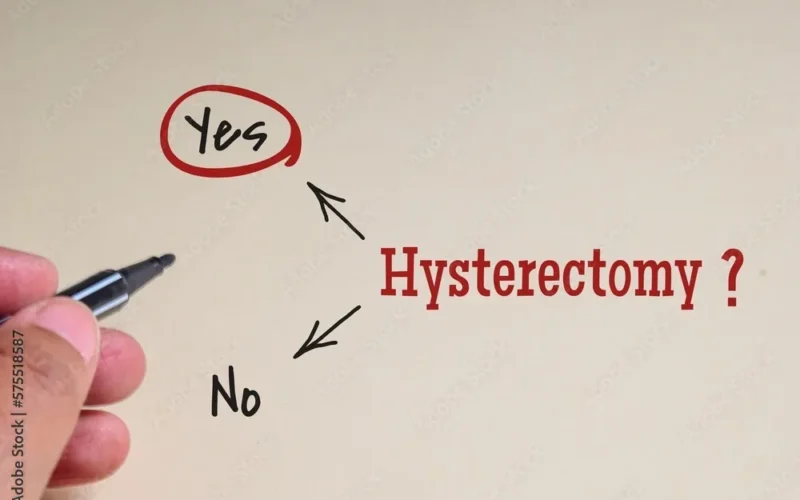A recent Newsweek article featured one Scottish woman’s experience of finding “freedom” at age 39 after two years of “excruciating” period pain—but at the high cost of her uterus and any possibility of future childbearing. But was the hysterectomy medically necessary? While the woman shared her understandable relief at no longer suffering from debilitating pain as well as “extremely heavy” and irregular periods following her hysterectomy, her story reads like a cautionary tale for several reasons. She herself experienced multiple complications during her postoperative recovery in the hospital, including life-threatening anaphylactic shock due to an anti-nausea medication. Even after she went home she ended up on antibiotics for concern of an infection in her surgical wound.
Perhaps most concerningly, the exact reason(s) for her severe pain and abnormally heavy periods appears never to have been discovered, as she wrote “ I underwent various routine checks and everything seemed to be working as it should be; there were no obvious problems. Eventually my gynecologist told me that aside from waiting until I had gone through menopause, removing my uterus would be the only way to stop what was happening.” She wasn’t encouraged to track her cycle—confirmed by her statement that “there was never any warning before my periods began”—and there is no mention of diagnostic testing, recommended lifestyle changes or supplements, or other alternative interventions or options being offered to her. To this day, the woman presumably remains in the dark about why she suffered as she did. Of course, she feels relief, as any woman in her shoes would. But the many unresolved question marks instead of sound medical explanations for the reasons underlying her problematic periods are troubling.
Is it the case that sometimes medical providers just can’t know what’s wrong, and a hysterectomy is really the only option to, for instance, stop excessive menstrual bleeding? What are the signs you need a hysterectomy? Is it possible that hysterectomies are overperformed in the United States? For answers to these questions and more, I spoke with Dr. Lester Ruppersberger and Dr. Kathleen Raviele, two retired OB/GYNs with a cumulative 70 years of clinical experience between them.
What is a hysterectomy?
Dr. Ruppersberger noted that a hysterectomy is simply the removal of the uterus. There are two different kinds, complete hysterectomy, also known as a total hysterectomy, which involves removal of the uterus plus the cervix, and incomplete or subtotal or supracervical hysterectomy, which removes the uterus but leaves the cervix. Dr. Ruppersberger explained that a woman might undergo a complete instead of an incomplete hysterectomy if she has had a history of abnormal Pap smears, or personal or family history of cervical cancer. Necessarily, a woman who has had any type of hysterectomy will no longer be able to bear children.
While many people mistakenly think that the Fallopian tubes and ovaries are removed during a hysterectomy, removal of the tubes (salpingectomy) and/or ovaries (oophorectomy) are separate procedures, though all would occur during the same surgery if total removal of reproductive organs was desired.
Why are hysterectomies performed?
Cancer
Dr. Ruppersberger noted, “The number one reason why hysterectomies would be medically necessary would be cancers, predominantly cancers of the cervix, the uterus, or of the ovaries.” A woman undergoing hysterectomy for cervical or ovarian cancer would likely have a radical hysterectomy, meaning removal of the uterus, cervix, ovaries, Fallopian tubes, and the pelvic lymph nodes “for the purposes of surgical staging, so you know how far the cancer was.” A woman experiencing uterine cancer might only need the uterus removed “and allow the tubes and ovaries to remain,” depending on how advanced the cancer is.
Large fibroid tumors
Sometimes hysterectomies are medically indicated due to fibroids, which are “benign tumors of the wall of the uterus,” located either inside the uterine wall or on the surface of the uterus. Fibroids occur much more often in African-American women than in white women. The larger the fibroid(s), the more likely it will compress other surrounding organs such as the bladder or bowel or the ureters which drain urine from the kidneys to the bladder. The patient’s age and possibility of future childbearing impact whether a woman is recommended for a hysterectomy due to fibroids. Dr. Ruppersberger said a case in which a hysterectomy might make sense could be, “a 45 year old woman with a uterus that’s the size of a 20 week pregnancy with multiple fibroids. Her fertility at 45 is going to be significantly compromised just by age, she has maybe finished her childbearing. Then a hysterectomy might be more appropriate.”
Myomectomy may be an alternative to hysterectomy
Conversely, Dr. Ruppersberger noted, a woman in her 20s who desires to have children in the future might undergo a myomectomy, “a surgical procedure where you just go in and remove the fibroids.” If the fibroids are inside the uterus, a hysteroscopic resection can be done, whereby a scope is inserted through the vagina (so the woman’s abdomen doesn’t need to be cut open) and an electrolyzed blade is used to scrape out the fibroids. But if the fibroids are on the outside of the uterus, hysteroscopy is off the table, and the options become a laparoscopic myomectomy, which is minimally invasive, or an open laparotomy, which is similar to a Cesarean section (C-section) incision. Even with myomectomy, doctors will ensure patients understand that fibroids may very possibly grow back. Furthermore, any patient who conceives afterward will have to give birth via C-section due to the scarring from the myomectomy. In the rarest of cases, a surgeon attempting to remove a fibroid via myomectomy may discover that it is actually a sarcoma, a cancerous growth that would necessitate a hysterectomy.
Endometriosis
Some women undergo hysterectomy to manage endometriosis. There are two types of endometriosis, Dr. Ruppersberger shared, and the first is endometriosis externa, “where the endometrial implants are on organs outside the uterus, whether it be the Fallopian tubes, the ovaries, behind the uterus, possibly on the surface of the bowel or bladder.” When the woman bleeds monthly, she also experiences bleeding in all these areas where endometriosis cells exist, leading to severe, sometimes debilitating pain, and inflammation that can lead to scarring so severe that infertility results.
Endometriosis interna, also known as adenomyosis, refers to endometriosis cells inside the muscle of the uterus, manifesting as swelling of the muscle wall and cramps and pain, even though an ultrasound may look normal. While a medical provider might trial a woman on cyclic progesterone in an attempt to regulate her bleeding or prescribe hormonal birth control to suppress her periods for a time, Dr. Raviele said that in some cases a woman will continue to have “severe bleeding that interferes with her life and causes anemia, and you just have to take her uterus out.”
Dr. Ruppersberger observed that while there is no cure for endometriosis, sometimes a complete hysterectomy with salpingo oophorectomy offers women the best chance at symptom relief. Unfortunately, this surgery induces menopause, with all its attendant symptoms, and, as mentioned before, precludes any further childbearing. Fortunately, there are many medications women can utilize for symptom relief before hysterectomy is considered the best option. Endometrial excision (differentiated from endometrial ablation here) or “near-contact laparoscopy”, which is offered by certain NaProTECHNOLOGY medical consultants, may be options as well.
Other reasons a hysterectomy might be medically necessary
In very rare cases, hysterectomy may be performed as a last resort in cases of advanced colon or bladder cancer, according to Dr. Ruppersberger. This is called pelvic exenteration, and involves removal of the vagina and cervix and ovaries and uterus, and possibly even of the bladder, anus, and/or intestine, according to the Cleveland Clinic.
One other very unusual situation would be in the case of a sexually transmitted infection (STI) like gonorrhea or chlamydia getting out of control, despite hospitalization and aggressive intravenous (IV) antibiotic treatment. If eventually the Fallopian tubes and ovaries were to become infected and require surgical removal, the uterus might be removed as well to avoid the need for ongoing hormone replacement therapy.
Signs you need a hysterectomy emergently
In rare cases, a hysterectomy will occur immediately after a woman gives birth, either via C-section or vaginally. Dr. Ruppersberger said that in rare cases “abnormal implantation of the placenta,” specifically “placenta increta, placenta percreta, or placenta previa” may cause life-threatening bleeding or hemorrhaging. If an emergent blood transfusion, injection of medications, packing of the uterus with sterilized gauze or sponges, intrauterine balloon tamponade, and/or uterine artery embolization (which can itself, unfortunately, lead to inability to successfully carry a baby due to inadequate uterine blood flow) are unsuccessful at slowing down the bleeding, an emergency hysterectomy may be performed to save the woman’s life.
Dr. Raviele added that patients should always be counseled on the remote possibility of a hysterectomy being done emergently if heavy, uncontrollable bleeding occurs during a separate reproductive procedure, like fibroid removal or endometrial excision. “With any conservative procedure, the end game is you always prepare the patient for the possibility of a hysterectomy in case you encounter something that you weren’t expecting.”
So what are the “signs” you need a hysterectomy?
Hysterectomy might be medically necessary for certain cancers when other treatments have failed, due to large fibroid tumors that have recurred or aren’t appropriate for myomectomy, in severe cases of endometriosis or adenomyosis, or in several other rare situations.
In the 2nd part of this 2-part series, Drs. Raviele and Ruppersberger explain the short-term and long-term complications that sometimes occur with hysterectomies, weigh in on whether hysterectomies might be overperformed in the United States today, and speak to the advantage a RRM-trained medical provider offers to women experiencing reproductive issues for which hysterectomy is sometimes recommended.







